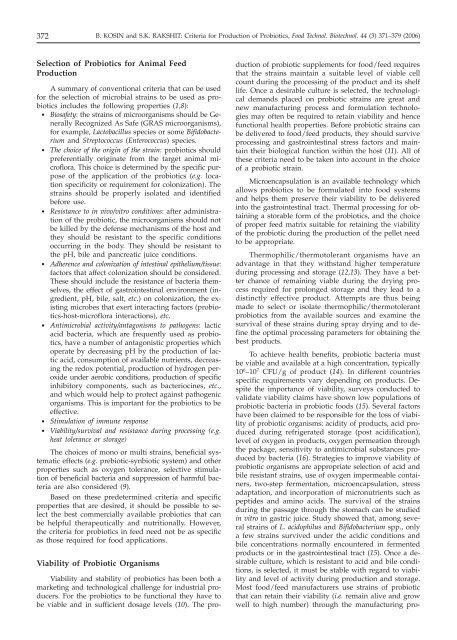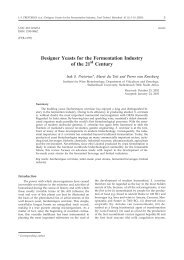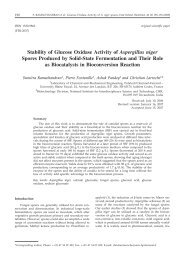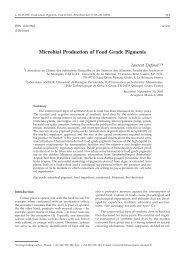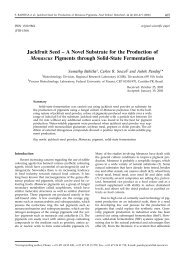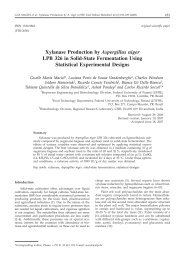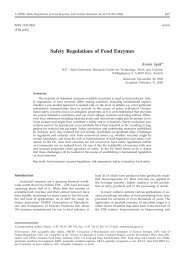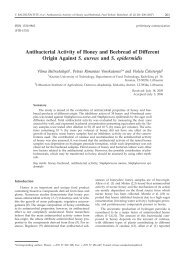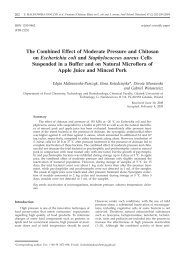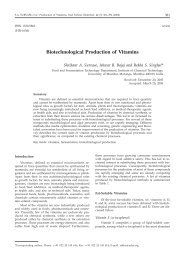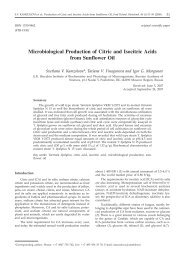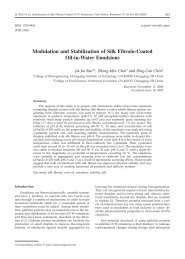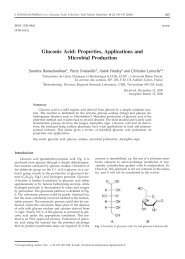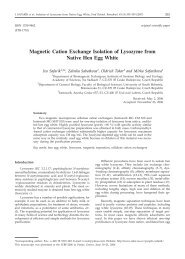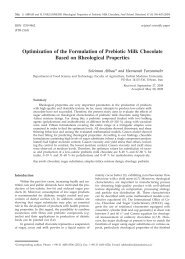A Review - Food Technology and Biotechnology
A Review - Food Technology and Biotechnology
A Review - Food Technology and Biotechnology
You also want an ePaper? Increase the reach of your titles
YUMPU automatically turns print PDFs into web optimized ePapers that Google loves.
372 B. KOSIN <strong>and</strong> S.K. RAKSHIT: Criteria for Production of Probiotics, <strong>Food</strong> Technol. Biotechnol. 44 (3) 371–379 (2006)<br />
Selection of Probiotics for Animal Feed<br />
Production<br />
A summary of conventional criteria that can be used<br />
for the selection of microbial strains to be used as probiotics<br />
includes the following properties (1,8):<br />
• Biosafety: the strains of microorganisms should be Generally<br />
Recognized As Safe (GRAS microorganisms),<br />
for example, Lactobacillus species or some Bifidobacterium<br />
<strong>and</strong> Streptococcus (Enterococcus) species.<br />
• The choice of the origin of the strain: probiotics should<br />
preferentially originate from the target animal microflora.<br />
This choice is determined by the specific purpose<br />
of the application of the probiotics (e.g. location<br />
specificity or requirement for colonization). The<br />
strains should be properly isolated <strong>and</strong> identified<br />
before use.<br />
• Resistance to in vivo/vitro conditions: after administration<br />
of the probiotic, the microorganisms should not<br />
be killed by the defense mechanisms of the host <strong>and</strong><br />
they should be resistant to the specific conditions<br />
occurring in the body. They should be resistant to<br />
the pH, bile <strong>and</strong> pancreatic juice conditions.<br />
• Adherence <strong>and</strong> colonization of intestinal epithelium/tissue:<br />
factors that affect colonization should be considered.<br />
These should include the resistance of bacteria themselves,<br />
the effect of gastrointestinal environment (ingredient,<br />
pH, bile, salt, etc.) on colonization, the existing<br />
microbes that exert interacting factors (probiotics-host-microflora<br />
interactions), etc.<br />
• Antimicrobial activity/antagonisms to pathogens: lactic<br />
acid bacteria, which are frequently used as probiotics,<br />
have a number of antagonistic properties which<br />
operate by decreasing pH by the production of lactic<br />
acid, consumption of available nutrients, decreasing<br />
the redox potential, production of hydrogen peroxide<br />
under aerobic conditions, production of specific<br />
inhibitory components, such as bacteriocines, etc.,<br />
<strong>and</strong> which would help to protect against pathogenic<br />
organisms. This is important for the probiotics to be<br />
effective.<br />
• Stimulation of immune response<br />
• Viability/survival <strong>and</strong> resistance during processing (e.g.<br />
heat tolerance or storage)<br />
The choices of mono or multi strains, beneficial systematic<br />
effects (e.g. prebiotic-synbiotic system) <strong>and</strong> other<br />
properties such as oxygen tolerance, selective stimulation<br />
of beneficial bacteria <strong>and</strong> suppression of harmful bacteria<br />
are also considered (9).<br />
Based on these predetermined criteria <strong>and</strong> specific<br />
properties that are desired, it should be possible to select<br />
the best commercially available probiotics that can<br />
be helpful therapeutically <strong>and</strong> nutritionally. However,<br />
the criteria for probiotics in feed need not be as specific<br />
as those required for food applications.<br />
Viability of Probiotic Organisms<br />
Viability <strong>and</strong> stability of probiotics has been both a<br />
marketing <strong>and</strong> technological challenge for industrial producers.<br />
For the probiotics to be functional they have to<br />
be viable <strong>and</strong> in sufficient dosage levels (10). The production<br />
of probiotic supplements for food/feed requires<br />
that the strains maintain a suitable level of viable cell<br />
count during the processing of the product <strong>and</strong> its shelf<br />
life. Once a desirable culture is selected, the technological<br />
dem<strong>and</strong>s placed on probiotic strains are great <strong>and</strong><br />
new manufacturing process <strong>and</strong> formulation technologies<br />
may often be required to retain viability <strong>and</strong> hence<br />
functional health properties. Before probiotic strains can<br />
be delivered to food/feed products, they should survive<br />
processing <strong>and</strong> gastrointestinal stress factors <strong>and</strong> maintain<br />
their biological function within the host (11). All of<br />
these criteria need to be taken into account in the choice<br />
of a probiotic strain.<br />
Microencapsulation is an available technology which<br />
allows probiotics to be formulated into food systems<br />
<strong>and</strong> helps them preserve their viability to be delivered<br />
into the gastrointestinal tract. Thermal processing for obtaining<br />
a storable form of the probiotics, <strong>and</strong> the choice<br />
of proper feed matrix suitable for retaining the viability<br />
of the probiotic during the production of the pellet need<br />
to be appropriate.<br />
Thermophilic/thermotolerant organisms have an<br />
advantage in that they withst<strong>and</strong> higher temperature<br />
during processing <strong>and</strong> storage (12,13). They have a better<br />
chance of remaining viable during the drying process<br />
required for prolonged storage <strong>and</strong> they lead to a<br />
distinctly effective product. Attempts are thus being<br />
made to select or isolate thermophilic/thermotolerant<br />
probiotics from the available sources <strong>and</strong> examine the<br />
survival of these strains during spray drying <strong>and</strong> to define<br />
the optimal processing parameters for obtaining the<br />
best products.<br />
To achieve health benefits, probiotic bacteria must<br />
be viable <strong>and</strong> available at a high concentration, typically<br />
10 6 –10 7 CFU/g of product (14). In different countries<br />
specific requirements vary depending on products. Despite<br />
the importance of viability, surveys conducted to<br />
validate viability claims have shown low populations of<br />
probiotic bacteria in probiotic foods (15). Several factors<br />
have been claimed to be responsible for the loss of viability<br />
of probiotic organisms: acidity of products, acid produced<br />
during refrigerated storage (post acidification),<br />
level of oxygen in products, oxygen permeation through<br />
the package, sensitivity to antimicrobial substances produced<br />
by bacteria (16). Strategies to improve viability of<br />
probiotic organisms are appropriate selection of acid <strong>and</strong><br />
bile resistant strains, use of oxygen impermeable containers,<br />
two-step fermentation, microencapsulation, stress<br />
adaptation, <strong>and</strong> incorporation of micronutrients such as<br />
peptides <strong>and</strong> amino acids. The survival of the strains<br />
during the passage through the stomach can be studied<br />
in vitro in gastric juice. Study showed that, among several<br />
strains of L. acidophilus <strong>and</strong> Bifidobacterium spp., only<br />
a few strains survived under the acidic conditions <strong>and</strong><br />
bile concentrations normally encountered in fermented<br />
products or in the gastrointestinal tract (15). Once a desirable<br />
culture, which is resistant to acid <strong>and</strong> bile conditions,<br />
is selected, it must be stable with regard to viability<br />
<strong>and</strong> level of activity during production <strong>and</strong> storage.<br />
Most food/feed manufacturers use strains of probiotic<br />
that can retain their viability (i.e. remain alive <strong>and</strong> grow<br />
well to high number) through the manufacturing pro-


